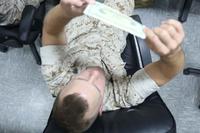The novel coronavirus has spread aboard the Arleigh Burke-class guided missile destroyer Kidd at sea in the Caribbean, forcing the medevac of one crew member and infecting at least 16 others, the Navy said Friday.
The ship is returning to port, where the crew of 300 will disembark and likely be quarantined while the destroyer undergoes a thorough cleaning, actions similar to the response to COVID-19 cases aboard the carrier Theodore Roosevelt in the Pacific, said Jonathan Hoffman, the Pentagon's chief spokesman. The Navy has not revealed the ship's destination.
The stricken sailor was taken to a hospital in San Antonio, Texas, on Thursday and "is already improving and will self-isolate," Rear Adm. Don Gabrielson, head of U.S. Naval Forces Southern Command, said in a Navy release.
Related: More than 25 Navy Ships Now Have Sailors Infected with the Coronavirus
"We are taking every precaution to ensure we identify, isolate and prevent any further spread onboard the ship," Gabrielson said.
Testing is continuing aboard the ship. "We expect additional cases" besides the total of 17 reported as of midday Friday, the Navy said.
The service has flown a medical team out to the Kidd to test the crew and treat infected sailors, Hoffman said at a briefing Friday.
The outbreak on the Kidd -- the second Navy ship after the Roosevelt to report coronavirus cases while deployed -- was first reported by Reuters.
The Kidd, whose homeport is Naval Base San Diego, was underway in the 4th Fleet's area of operations in support of the recently enhanced counter-narcotics missions of U.S. Southern Command when the outbreak was detected.
The last port visit for the 563-foot destroyer, which was commissioned in 2007, was not immediately disclosed.
The specialized medical team deployed to the ship is conducting contact tracing with the sailors who tested positive to determine the origins of the infections, the Navy said.
Two days before the outbreak on the Kidd was disclosed, the Pentagon announced new plans to prevent the spread of coronavirus and test the entire force, including specific guidelines for ships and submarines where social distancing is difficult to impossible.
At a Pentagon briefing Wednesday, Deputy Defense Secretary David Norquist said that the new plan for sailors about to deploy on ships and submarines would have them screened with questionnaires and thermometers to identify at-risk personnel.
Those deemed to be at risk will then be put in quarantine for 14 to 21 days to identify possible infections, he said.
"Prior to leaving quarantine, we will conduct a swab test and a temperature check to identify individuals who are infected, but still do not show it," Norquist said. "As the unit then moves to its mission, [we] will keep the group together, but [with] limited outside interaction to prevent introduction of infection from outside."
The intensified preparations to ensure crews' safety were prompted by the infections that spread quickly aboard the carrier Roosevelt and led to the death of one sailor.
The carrier was underway in the Pacific when the outbreak occurred and was forced to put into port March 26 in Guam, where most of the crew disembarked and went into quarantine.
The Navy said Thursday that 840 Roosevelt sailors had tested positive for the coronavirus, which is more than 17 percent of the roughly 4,845 sailors on board.
One sailor, Chief Aviation Ordnanceman Charles Thacker, 41, died from the virus last week.
-- Richard Sisk can be reached at Richard.Sisk@Military.com.
Read more: Quarantined Sailors Take to Balconies to Cheer for the Marines Helping Them












